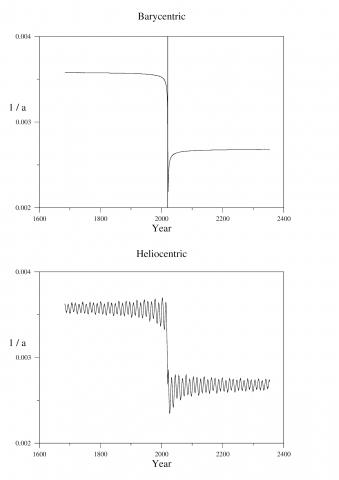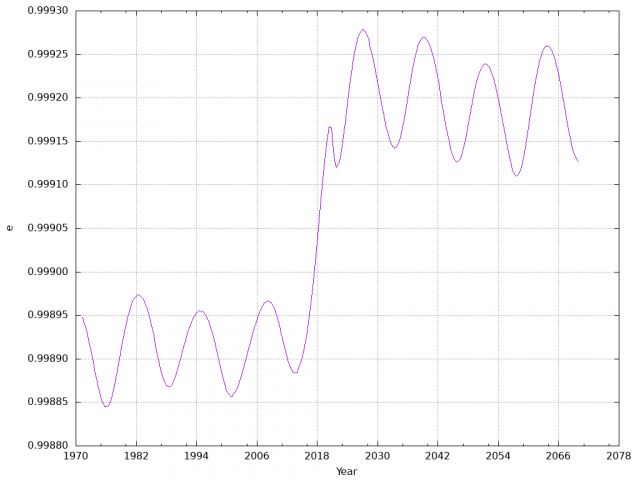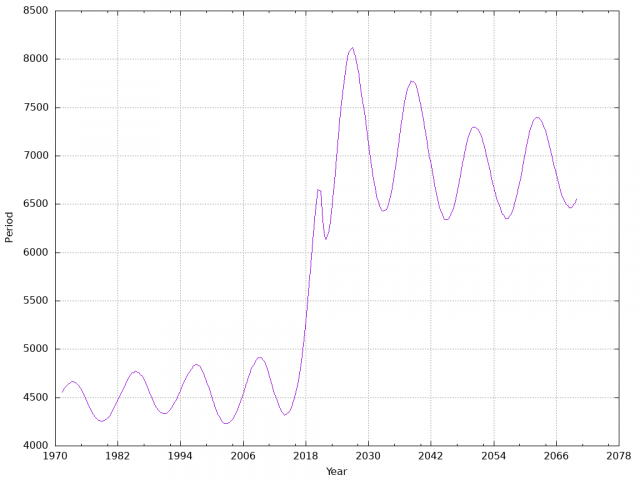Forum Replies Created
-
AuthorPosts
-
 Nick JamesParticipant
Nick JamesParticipantThe attached are updated elements of 2020 SW including my astrometry from last night. These should help if you are using any program which uses the MPC elements. This is actually a text file but for some reason you can’t upload those.
 Nick JamesParticipant
Nick JamesParticipantI managed to get some astrometry of this very small object this evening and it was a bit off track. An updated ephemeris is attached. Tonight it is around 19.7, tomorrow night (Tuesday) it will be 18.6 moving at 5″/min and Wednesday night it will be up to 16th mag but accelerating through 30″/min. It then moves rapidly south and we lose it as it comes within the geostationary satellite belt for a short period around Sept 24.45.
Note the ephemeris is for my location and the position will be different for you. This will become more significant the further from Essex you are and the closer the object gets. Let me know if you want an ephemeris for your location.
 Nick JamesParticipant
Nick JamesParticipantHere’s an image tonight in pretty good seeing (FWHM = 2.4 arcsec). It is in a very crowded field and, as Gary says, now it has faded it is difficult to separate from the star just to the west.
 Nick JamesParticipant
Nick JamesParticipantHere is a link to an animation showing how the star and nebula have changed over the last two years. I don’t think animated GIFs work in this forum.
 Nick JamesParticipant
Nick JamesParticipantI have a vintage SXVR-H18 which works fine off a USB3 hub.
 Nick JamesParticipant
Nick JamesParticipantThat’s quite close to where I stay when I’m on LP. Hopefully they will get it under control. A local news report here.
 Nick JamesParticipant
Nick JamesParticipantI had an email from Graeme Waddington pointing out that the periodic wiggles due to Jupiter and the other planets disappear if you use a barycentric coordinate system rather than heliocentric. This is because, when the comet is far out, it is orbiting around the centre of mass of the Solar System (the barycentre) which is not exactly at the centre of the Sun. Graeme’s plots are attached. The y axis is 1/a which, if you remember from my first post, is equal to (1-e)/q so it has the big advantage that it is well conditioned for orbits where e is near to 1 (i.e. it doesn’t tend to infinity as e tends to 1). Graeme notes “At the ends of the time frame plotted the comet is at 244 au and 250 au from the sun –> P(orig.) = 4674 yr, P(future) = 7200 yr. For a similar integration using the JPL15 orbit I get 4434 and 6718 years respectively.”

 Nick JamesParticipant
Nick JamesParticipanthttps://britastro.org/node/23563. I get 12.6 unfiltered last night using Gaia DR2 G mags.
 Nick JamesParticipant
Nick JamesParticipantRay,
The change is mainly due to the gravitational perturbations of the major planets. The orbital period is very sensitive to the eccentricity so a small change in e has a big effect on the period since a = q / (1 – e) and P = a^(3/2). The attached plots show the results you get if you integrate the current orbit forwards and backwards including the gravitational effects of all the planets and the biggest asteroids. There is a clear 12 year signature which is Jupiter but you can also see the large change in period corresponding to the small change in eccentricity.



 Nick JamesParticipant
Nick JamesParticipantThanks to Hazel for pointing out that we need a new chart for this comet. Here it is: https://britastro.org/wp-content/uploads/sites/2020f3_Aug.pdf
 Nick JamesParticipant
Nick JamesParticipantI’ve only just got around to processing my images of C/2020 F3 (NEOWISE) from July 22. An animation is here:
http://www.nickdjames.com/Comets/2020/2020f3_20200722_ndj.gif
This shows a field of view of 33×22 arcmin processed using a Larson-Sekanina filter with r=2, th=10 deg. There are 9 frames each of around 330s duration (from 2143 – 2228). You can clearly see motion in the tail and material spiraling out from the centre of the coma. The small black dot at the centre of the coma is the reference pixel for the filter.
I have done quite a few experiments with this data and I think the parameters I have chosen are the best compromise to show detail and motion (i.e. around 300s integrations and L-S with r=2, th=10).
It always amazes me that so much relative motion is visible in active comets over such a short period of time.
 Nick JamesParticipant
Nick JamesParticipantBill, this is very interesting. Can you give a bit of an explanation of how you got these maps. Did you take images in two orthogonal polarizations and then difference them? If so, how do you calibrate them unless they were taken at the same time.
 Nick JamesParticipant
Nick JamesParticipantThere is a lot of detail in the centre of the coma too https://britastro.org/node/23370
 Nick JamesParticipant
Nick JamesParticipantAttached is the blue channel of my widefield image last night (Sony A7s, 50mm f/1.8 lens). The FoV is around 40 x 27 deg and the subs are stacked on the comet’s motion. It was hazy last night and I have horrible gradients to get rid of. Also my flat field hasn’t worked properly. This shows up as concentric rings in the sky background. I need to redo the flat and do some more fiddling to get an image but this shows an ion tail around 25 deg long.

 Nick JamesParticipant
Nick JamesParticipantI’d noticed the colour change too. That’s very interesting. I should have been flying off to La Palma this weekend but that was cancelled due to C19. That comet would have been a great target from the top of the mountain.
 Nick JamesParticipant
Nick JamesParticipantIt certainly looks more prominent and the dust tail close to the nucleus doesn’t have the prominent dark band any more. Here’s my take from this morning. https://britastro.org/node/23324
 Nick JamesParticipant
Nick JamesParticipantVery impressive result Robin.
 Nick JamesParticipant
Nick JamesParticipantDavid, That is really good. I’m even more amazed that you had clear skies last night! It was raining here in Chelmsford.
 Nick JamesParticipant
Nick JamesParticipantJohn Mason and the South Downs Planetarium crew have done a great video for the general public on comets in general and C/2020 F3 in particular. You can find it here.
 Nick JamesParticipant
Nick JamesParticipantDavid, I hold you personally responsible that I now have to hoover out my keyboard after reading that Daily Mail article while eating my lunchtime sandwich. Do they actually pay their astrologer to write this stuff? I have to admit though that “Comet Neowise” is certainly having a significant influence on my life at the moment.
-
AuthorPosts
